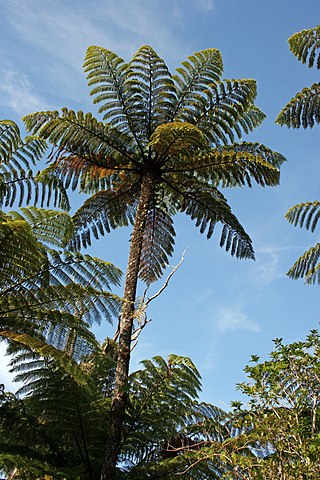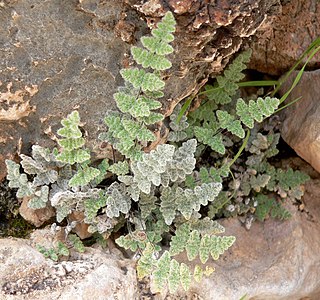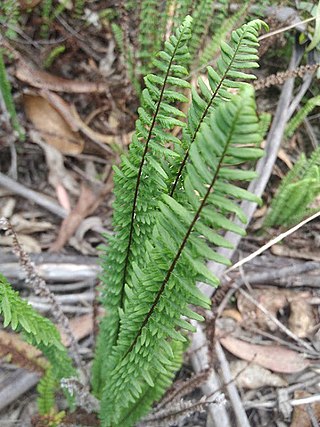
Pteris (brake) is a genus of about 300 species of ferns in the subfamily Pteridoideae of the family Pteridaceae. They are native to tropical and subtropical regions, southward to New Zealand, Australia, and South Africa, north to Japan and North America. 78 species are found in China. Some species of Pteris have considerable economic and ecological value, such as Pteris multifida, Pteris ensiformis, Pteris vittata can be used for ornamental purposes; as a hyperaccumulator, Pteris multifida and Pteris vittata can be used to control soil pollution.

Cyathea is a genus of tree ferns, the type genus of the fern order Cyatheales.

Pellaea is a genus of ferns in the Cheilanthoideae subfamily of the Pteridaceae. The genus name is derived from the Greek word πελλος (pellos), meaning "dark," and refers to the brown stems. Many members of the genus are commonly known as cliffbrakes. They primarily grow in rocky habitats, including moist rocky canyons, slopes, and bluffs.

Notholaena, cloak fern, is a genus of ferns in the Cheilanthoideae subfamily of the Pteridaceae. Ferns of this genus are mostly epipetric or occurring in coarse, gravelly soils, and are most abundant and diverse in the mountain ranges of warm arid or semiarid regions. They typically have a creeping or erect rhizome and leaves that are pinnatifid to pinnate-pinnatifid with marginal sori protected by a false indusium formed from the reflexed margin of the leaf. Members of Notholaena also have a coating of whitish or yellowish farina on the surfaces of the leaves. The farina is often limited to the abaxial (lower) leaf surface, but may occur on the adaxial (upper) leaf surface as well. Members of the related Pentagramma genus have a similar lower leaf-surface farina.

Pteridaceae is a family of ferns in the order Polypodiales, including some 1150 known species in ca 45 genera, divided over five subfamilies. The family includes four groups of genera that are sometimes recognized as separate families: the adiantoid, cheilanthoid, pteridoid, and hemionitidoid ferns. Relationships among these groups remain unclear, and although some recent genetic analyses of the Pteridales suggest that neither the family Pteridaceae nor the major groups within it are all monophyletic, as yet these analyses are insufficiently comprehensive and robust to provide good support for a revision of the order at the family level.

Pleopeltis is a genus of ferns in the family Polypodiaceae, subfamily Polypodioideae, according to the Pteridophyte Phylogeny Group classification of 2016 (PPG I). The genus widely distributed in tropical regions of the world, and also north into temperate regions in eastern North America and eastern Asia. Several species are known by the common name scaly polypody and resurrection fern.

Hymenophyllum is a genus of ferns in the family Hymenophyllaceae. Its name means "membranous leaf", referring to the very thin translucent tissue of the fronds, which gives rise to the common name filmy fern for this and other thin-leaved ferns. The leaves are generally only one cell thick and lack stomata, making them vulnerable to desiccation. Consequently, they are found only in very humid areas, such as in moist forests and among sheltered rocks. They are small and easy to overlook.

Tectaria is a genus of fern in the family Tectariaceae, according to the Pteridophyte Phylogeny Group classification of 2016. Halberd fern is a common name for species in this genus.

Argyrochosma is a genus of ferns known commonly as false cloak ferns. The genus is included in the Cheilanthoideae subfamily of the Pteridaceae. Species now in this genus were previously treated as members of related genera Notholaena or Pellaea but were segregated into their own genus in 1987. These ferns, of which there are about 20 species, are mostly native to the Americas, from North to South and including the Caribbean, while one species, A. connectens, is known from Sichuan, China. They are commonly found growing in cracks between rocks. Their leaves are generally shorter than 40 cm (16 in) and have rounded bluish or grayish green segments. Often the lower surface of the segments is coated in a white dust, and the sporangia contain brown spores.

Jamesonia is a genus of ferns in the subfamily Pteridoideae of the family Pteridaceae. It now includes the formerly separate genus Eriosorus.

Christella is a genus of around 70-80 species of ferns in the subfamily Thelypteridoideae of the family Thelypteridaceae in the Pteridophyte Phylogeny Group classification of 2016. Other sources sink Christella into a very broadly defined genus Thelypteris. The genus was named after Konrad H. Christ, a Swiss botanist. The distribution of these plants is mostly in the tropics and sub tropical areas. An Australian example is C. dentata.
Calciphilopteris is a genus of ferns in the family Pteridaceae. It is native to India and China, southward to Australia. Its four species grow in crevices in limestone or they cling to the rock itself.

Cheilanthoideae is one of the five subfamilies of the fern family Pteridaceae. The subfamily is thought to be monophyletic, but some of the genera into which it has been divided are not, and the taxonomic status of many of its genera and species remains uncertain, with radically different approaches in use as of December 2019.

Adiantopsis is a genus of ferns in the subfamily Cheilanthoideae of the family Pteridaceae.

Odontosoria is a genus of ferns in the family Lindsaeaceae.
Lytoneuron is a genus of ferns in the subfamily Cheilanthoideae of the family Pteridaceae. Species are native to South America, many to Brazil.

Goniopteris is a genus of ferns in the family Thelypteridaceae, subfamily Thelypteridoideae, in the Pteridophyte Phylogeny Group classification of 2016. Other sources sink Goniopteris into a very broadly defined genus Thelypteris.
Stigmatopteris is a genus of ferns in the family Dryopteridaceae, subfamily Polybotryoideae, in the Pteridophyte Phylogeny Group classification of 2016.















